When, a few months ago, we met Paolo Griffa and his cuisine, at Identità Golose Milano for one of our Italian Breakfasts (read the report here), we had the feeling that we had never perceived him to be so centred, so mature. After a long (for his 32 years) and prestigious journey of professional growth, the chef had finally found the context and the project where he could express himself at his best, showcasing his talents and, above all, his many ideas.
After our first visit to Caffè Nazionale di Aosta, which Griffa opened at the end of August 2022, that feeling became a solid certainty. After a truly satisfying dinner - as this writer has not had for quite a while - listening to the chef's tales as he explored the meanders of the lower floor of the café, where Griffa has his headquarters divided between kitchen, pastry shop, cellar and a special room for private events, it became clear he has developed a project with uncommon care and intelligence.
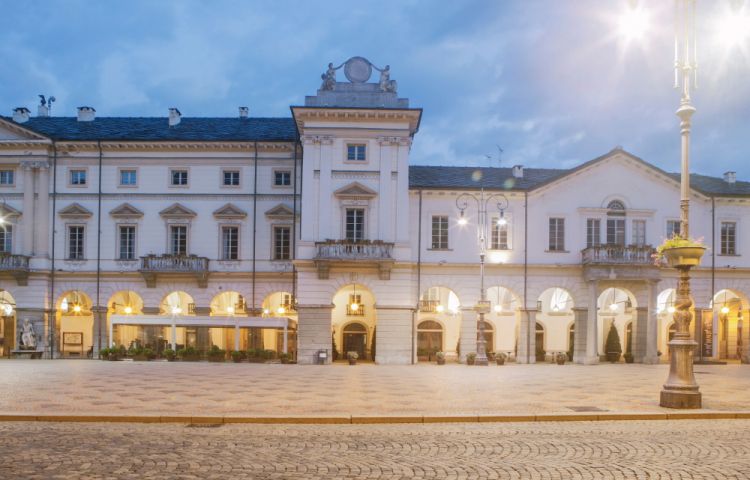
The exterior, from the square
To get there, you must reach Aosta's central square dedicated to the Catholic anti-fascist
Émile Chanoux: a large and, in its own way, austere rectangle, under the arcades of which is this historic restaurant, active since the 19th century, which was taken over thanks to a tender promoted by the municipality. The chef immediately loved its old-world charm, its multifaceted character, which he wished to respect and celebrate, enhancing his own versatility in the process.
Already in his previous experience, at the head of the catering offer at Grand Hotel Royal and Golf in Courmayeur from 2017 to 2022, Griffa demonstrated his ability to excel both in the organisation of a complex proposal such as that of a luxury hotel, which has to satisfy its guests 24 hours a day in different contexts, and in the creation of a gourmet restaurant, the Petit Royal, which was awarded its first star less than two years after opening.
But here there is more, definitely more. In the meantime, the
Caffè Nazionale project arose from the desire to have a gourmet restaurant open all year round, lunch and dinner, in a city, dealing with a very different public from that found in mountain tourism resort like Courmayeur. This has led
Griffa to a proposal that is largely different from that of the
Petit Royal, avoiding tasting menus made of countless courses, in order to approach a broader public: we thus find two menus, one of five and one of seven courses, with some choices to be made, almost as if one were ordering à la carte. A road taken also to allow those who return to sit at the
Caffè Nazionale to experience new and different things.
Then there are the lighter, more dynamic options, more in line with the café format, mentioned in the name. The breakfasts, with only specialty coffees and a selection of
viennoiserie to die for, and then cakes, monoportions, chocolate of the highest quality. Many sweet products are also for take-away (there is a well-stocked
e-commerce for those who find it hard to get to Valle d'Aosta), with packaged in an elegant and original way that immediately stands out.
And then there’s lunch, with the possibility of tasting
Griffa's cuisine in a lighter business lunch, aperitifs... and back to dinner. So, every day, from 7 a.m. to 8.30 p.m., for the bar and cafeteria, while the restaurant is closed on Tuesdays and Wednesdays.
The restaurant is divided into three rooms, but one of these is a 14th century chapel, which has been completely restored by stripping it of the Gothic features that had been superimposed over time, giving it back its Romanesque soul instead. Taking a seat at one of the tables in this room of such pure beauty is, quite simply, thrilling. In the attention devoted to the restoration of the chapel, one also finds the meticulous effort that
Paolo Griffa, with his many collaborators and fellow travellers, has put into every corner of
Caffè Nazionale. On the lower floor there once were storage rooms, nothing special: today there is hyper-contemporaneity applied to signature cuisine.
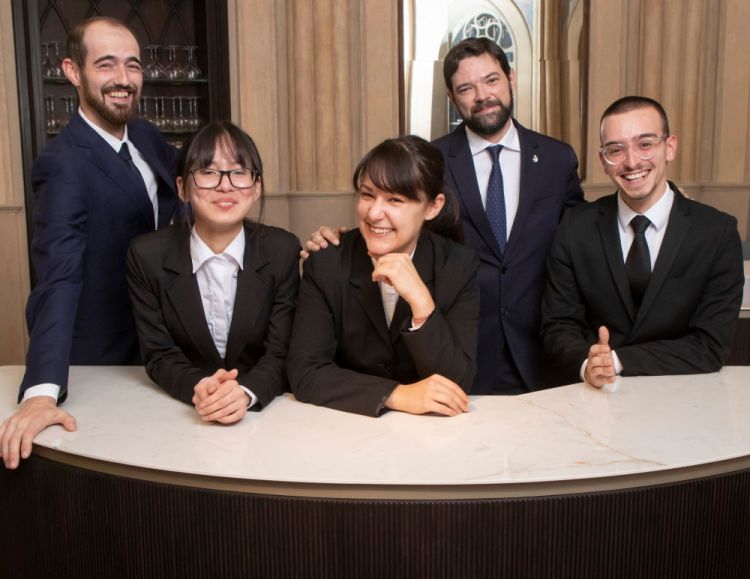
The dining room brigade: Federica Tomasini in the centre, to her left Alessandro Mantovani
Commitment and care, as well as intelligence and skill, are characteristics that distinguish not only the chef, but also those in charge of the dining room at
Caffè Nazionale:
Federica Tomasini and sommelier
Alessandro Mantovani, together with the other members of the brigade, guide customers with sensitivity, grasping nuances and needs, indulging them and anticipating them. It is a close-knit team that has been working with
Griffa for several years, already at the
Petit Royal. It is worth emphasising that Griffa's relationship with the
Grand Hotel Royal and Golf in Courmayeur has remained excellent, so much so that the chef retains firm control over the catering at that hotel as a consultant, and has been able to transfer to Aosta an important part of the wine selection he acquired during his years at higher altitudes (in addition to the Michelin star, which technically has been 'moved' from the
Petit Royal to the
Caffè Nazionale).
These wines certainly include a lot of France, showing the chef's deep love for that food and wine culture (also developed during his experiences at
Le Châteaubriand and at
Serge Vieira's), but also a lot of Valle d'Aosta. We suggest relying on the gentle competence of
Alessandro Mantovani, who also pours into the glasses small stories of producers who from two hectares, when not from even less, extract a few hundred special, different, unique bottles. Isn't that why you fall in love with wine? He will also also guide you through the cheese trolley, only from Valle d'Aosta, offering superfine tastings.
Then there is the cuisine, of course. We reiterate the initial judgement: never so mature, so in tune between aesthetic research, which has always been a strong feature of Griffa's style, and the ability to propose simple, immediate flavours and combinations. Irony and playfulness, wow effect, rich flavours. And this is just the beginning: how much more can Paolo Griffa grow and surprise? We end, only to present the dishes from the menu that we tasted, with a new feeling: much more, much more.
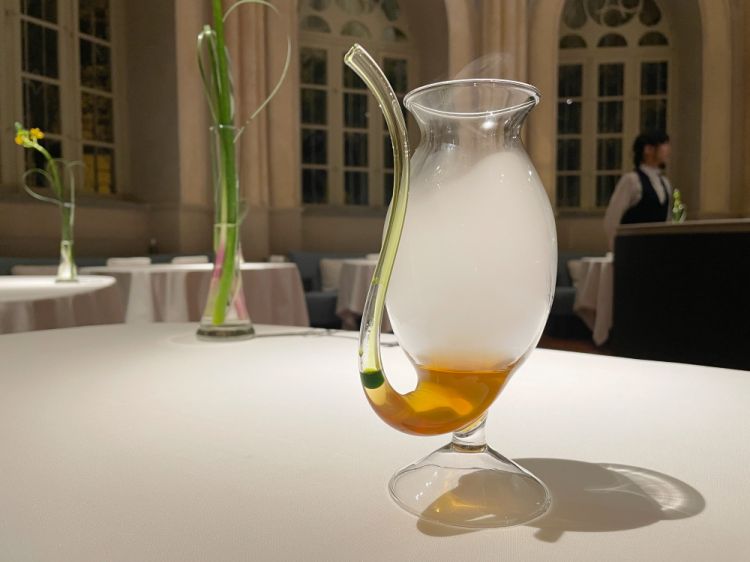
The first welcome is Pumpkin water and parsley oil, to be mixed by first blowing into the straw, then sucking and drinking
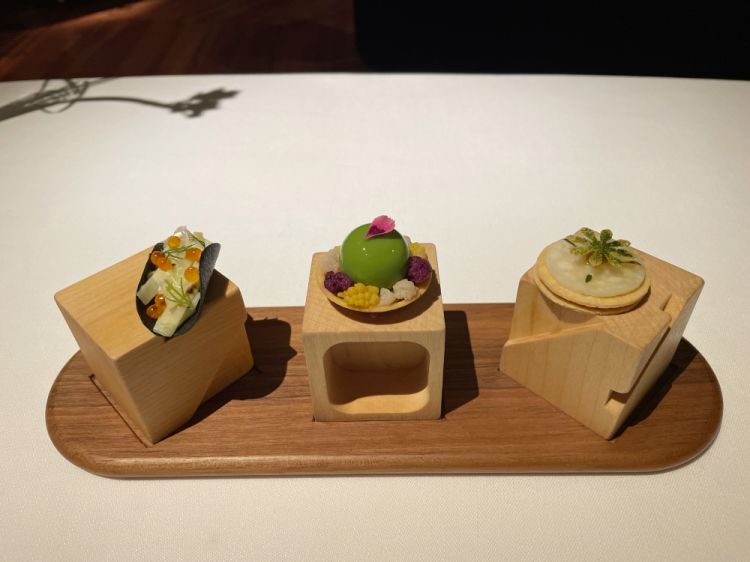
Double amuse bouche, all very tasty: for the first part, left to right Vegetable charcoal taco with celeriac, pomelo and trout roe - Tartlet with broccoli cream and cauliflower pickle - Pasta brick, celeriac, chestnut cream, herb wafer
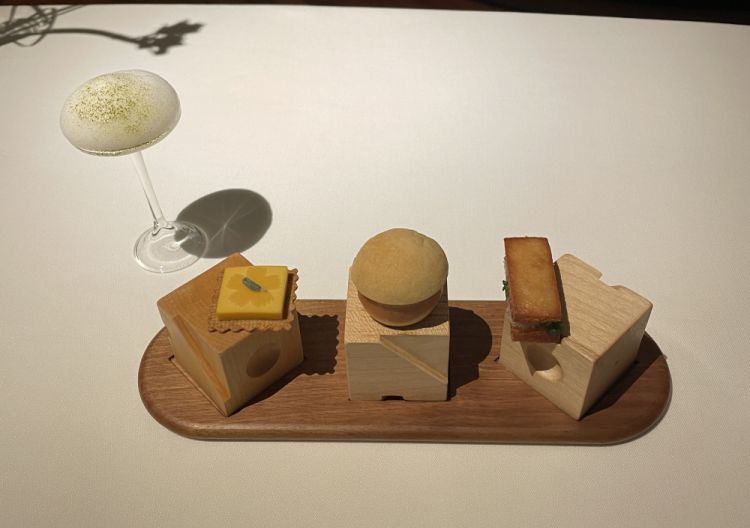
Second part, left to right: Mint mousse, bergamot sorbet, matcha tea powder (to be eaten at the end, cleansing the mouth very effectively) - Amaretto shortcrust pastry, pumpkin flan - Mini Venetian with thyme béchamel sauce - Fried sandwich with smoked eel
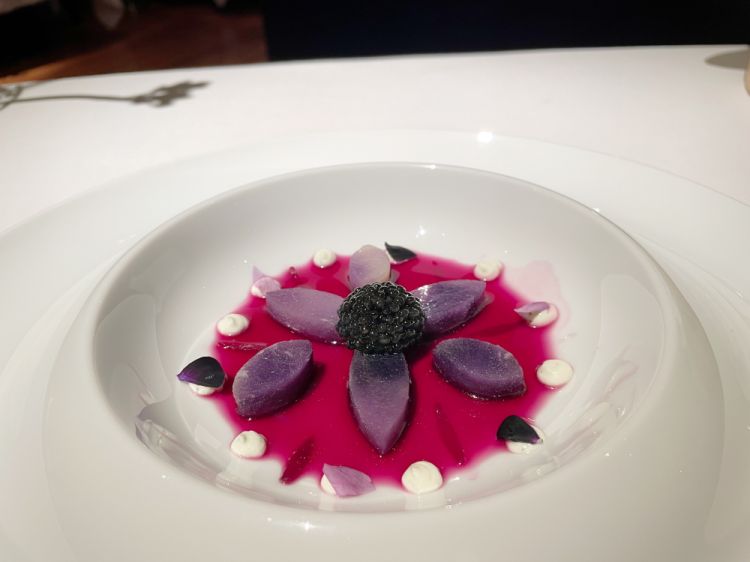
The actual tasting menu opens with Viola: potatoes, flowers and cabbage. Paolo Griffa's aesthetic research produces a small chromatic masterpiece, in which the purple potatoes retain the perfume of the violet liqueur with which they are seasoned, the purple cabbage and mustard sauce is as beautiful as it is good and perfect to accompany the dill-flavoured fromage blanc tips, and the iodised savouriness of the caviar and the small sweet/sour touches of the pickled Tropea onion complete the bite. Perfect start
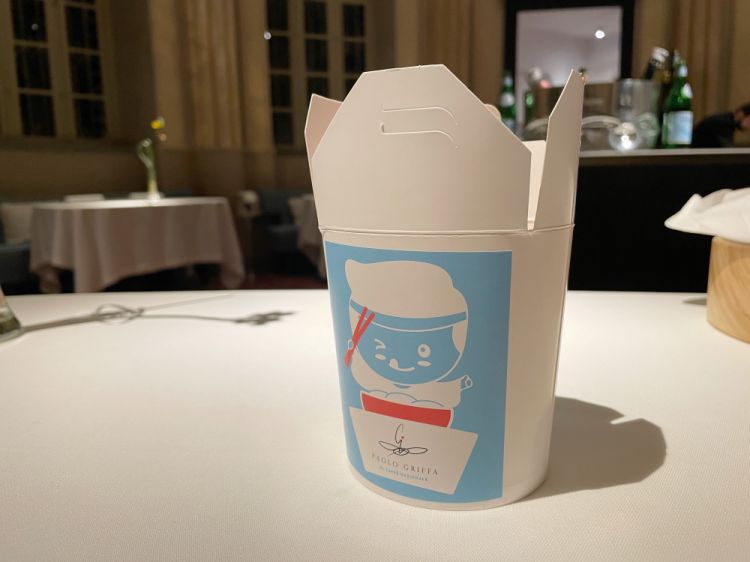
Let's play: Ramen Valdostano starts from an inspiration of Japanese street food that is now also well known in Italy, which is served in a container that is exactly suited to the context of street food. In a fine dining restaurant? Indeed
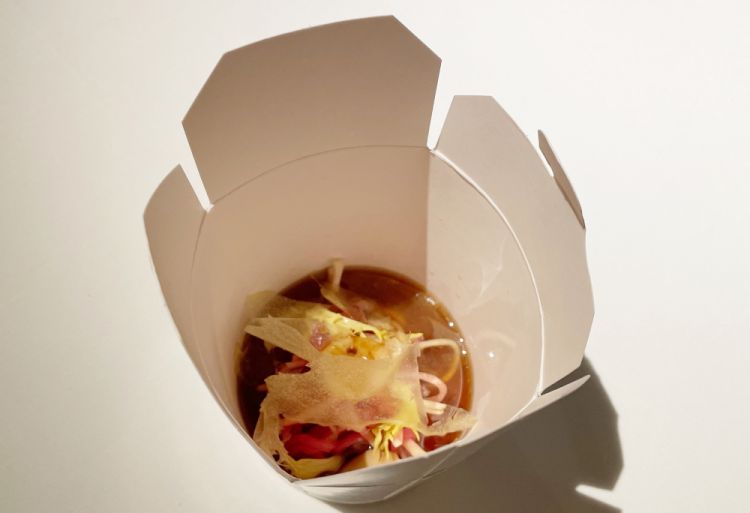
Inside, only raw materials from Valle d'Aosta. There are no noodles, replaced by beef noodles, cut in the direction of the fillet's fibre, the shitake mushrooms are replaced by cardoncelli, then Arnad lard, oxidised quail eggs, curly salad instead of seaweed, and again turnips, daikon. And the katsuobushi is in fact a finely chopped polenta
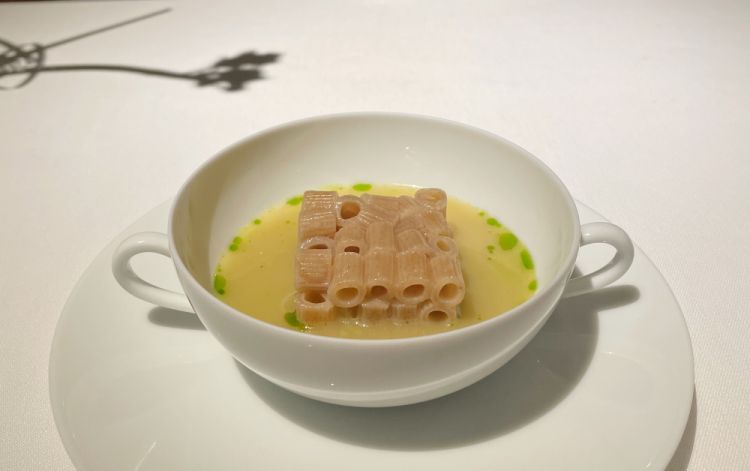
Pasta alla Valpellinese
The soup from which this dish takes its inspiration is a local must, based mainly on Savoy cabbage and fontina cheese, with a thousand little variations as is always the case with traditional recipes. Paolo Griffa has turned it into a pasta dish, but has managed to condense its authentic flavour: the fontina is in the form of oxtail broth flavoured with the local cheese, underneath there’s a cream of Savoy cabbage, garnished with bay-flavoured oil, and then the pasta: spelt ditalini cooked under pressure and placed in the form of a cube, a tribute to Arnaldo Pomodoro
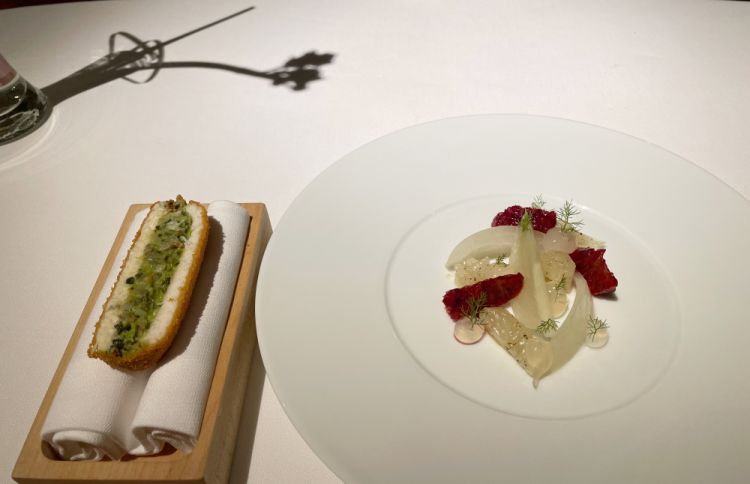
In its simplicity, this dish won us over with its refined delicacy: char and chard with fennel and citrus fruit salad.
Both elements stand out when tasting: the salad surprises with its spicy nuances, with fennel cooked in anise and juniper liqueur, blood oranges dressed with oil and salt, and then drops of gin gel. The char, on the other hand, is an explosion of flavour, breaded, fried, stuffed with chard
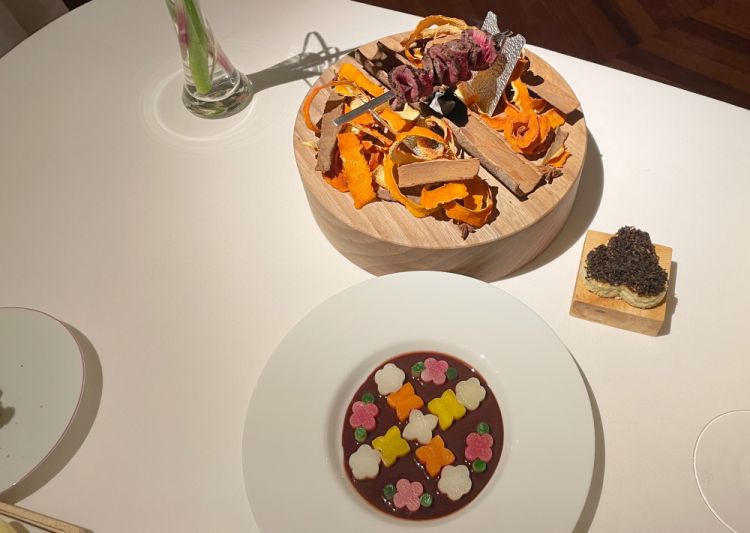
Barbecued venison and sauce royale
Venison is a passion of Paolo Griffa's: in this case he plays with it by seasoning it with Tchuli pepper from the Himalayas, and then proposing it on skewers, smoked with mountain herbs, orange peel and cinnamon. On the plate below, typical stew vegetables, dipped in a sauce royale made with chocolate from Venezuela and blood. In addition to the venison chunks themselves, they serve a brioche bun covered with fine black truffles. Aromas of forest, perfect meat, a bewitching sauce: the savoury journey ends with an admirable dish
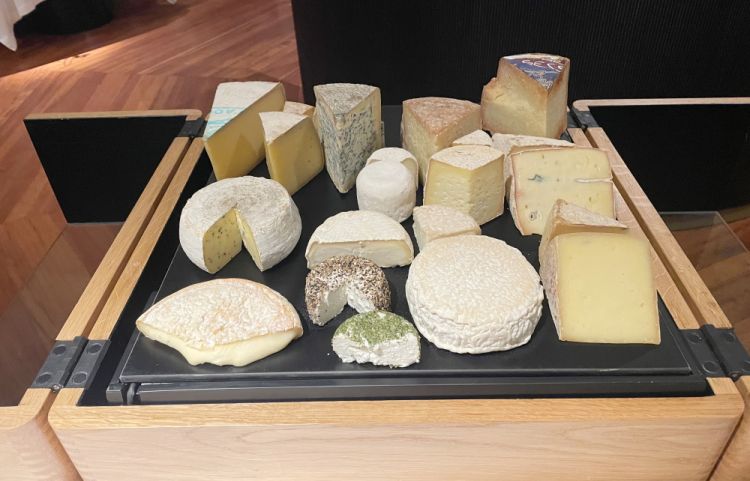
Long live the cheese trolley: when it is selected, and presented, with such care and love, it warms the heart. Only small local producers, following the rhythm of the seasons
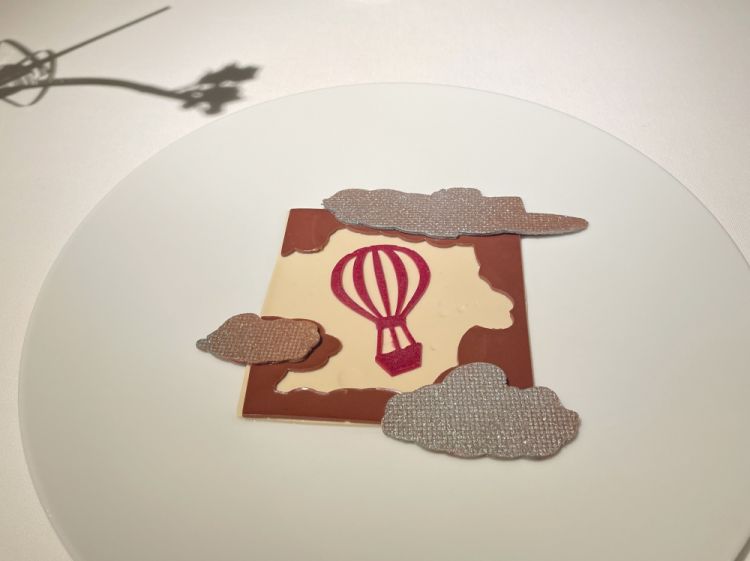
The sweet conclusion is Volare
The balloon is made of raspberry cream, the base is a panna cotta flavoured with an infusion of Jamaican Blue Mountain speciality coffee. Next to the gianduja cream, the clouds are made of shortbread with dark chocolate and raspberries. Not to be missed, for coffee lovers, is the specialty coffee menu with which to end a great dinner with refined grace.
Translated into English by Slawka G. Scarso